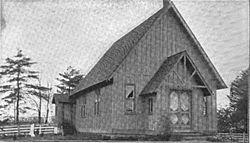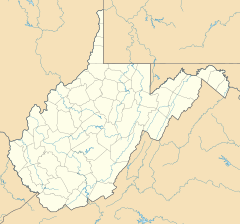Okonoko, West Virginia facts for kids
Quick facts for kids
Okonoko, West Virginia
|
|
|---|---|

Epiphany Episcopal Church (c. 1900) in Okonoko
|
|
| Country | United States |
| State | West Virginia |
| County | Hampshire |
| Magisterial district | Gore Springfield |
| Post office established | 1843 |
| Elevation | 568 ft (173 m) |
| Time zone | UTC-5 (Eastern (EST)) |
| • Summer (DST) | UTC-4 (EDT) |
| ZIP codes |
25434
|
| GNIS feature ID | 1555261 |
Okonoko is a small, unincorporated community in Hampshire County, West Virginia. It's located in the northern part of the county, right along the Potomac River. This area is also close to the CSX railroad line, which used to be part of the old Baltimore and Ohio Railroad.
The community was first known as Cacaponville. This name came from its closeness to the Little Cacapon River. In 1843, a post office was opened here. Then, in 1853, the name was changed to Okonoko. By the late 1800s, Okonoko had grown to about 100 people. The post office stayed open until 1958. After that, mail for Okonoko was sent through the nearby town of Paw Paw, West Virginia.
Contents
Okonoko's Location and Surroundings
Okonoko is in northern Hampshire County, West Virginia. It sits right where the Potomac River meets streams from Miller and Brights Hollows. The community is mainly found along Okonoko Road (West Virginia Secondary Route 5/6). This area is at the edge of forested mountains, where the hollows open up to the Potomac River valley.
In 1885, two mountain ridges nearby were called Mount Sinai and Levels Peak. The mouth of Town Creek is about 1 mile west of Okonoko. The Little Cacapon River's mouth is about 1.7 miles to the east.
Okonoko is about 568 feet (173 meters) above sea level. The community of Little Cacapon is about 1.7 miles east. Levels is about 3.1 miles southwest. The town of Paw Paw is about 3.5 miles east. You can reach Okonoko from these places using Okonoko Road. Right across the Potomac River, in Maryland, you'll find the Chesapeake and Ohio Canal and the Chesapeake and Ohio Canal National Historical Park.
A Look at Okonoko's History
In 1838, the Baltimore and Ohio Railroad decided to extend its main line. This new line would go west from Harpers Ferry to Cumberland, Maryland. Construction began in 1839. By November 1842, the railroad line officially opened to Cumberland. After the railroad arrived, Okonoko grew into a busy railroad town. Across the river, the Chesapeake and Ohio Canal also opened for trade in 1850.
How Okonoko Got Its Name
Okonoko was first called Cacaponville. This was because it was next to the mouth of the Little Cacapon River. The United States Post Office Department opened a post office there in March 1843. The name changed to Okonoko in June 1853. The name "Okonoko" comes from a Native American word, "Macocanoco." It means "there are high peaks, or ridges." Interestingly, Okonoko is also a palindrome, meaning it reads the same forwards and backward.
The post office closed for a short time in 1856 but reopened that same year. It closed again in 1867 but was reestablished in 1868. Mail from Okonoko was then sent to other nearby post offices like Levels, Points, Higginsville, and Slanesville.
Okonoko During the Civil War
During the American Civil War, Okonoko was the site of an attempted raid. On April 10, 1864, Confederate soldiers tried to attack a Baltimore and Ohio Railroad train. Four privates from the 54th Pennsylvania Infantry Regiment were patrolling the railroad tracks. They saw a light and realized it was a group of 27 Confederate cavalry soldiers. The Confederates fired at the Union soldiers, wounding two of them. One of the Union soldiers later died from his injuries.
Growth and Orchards
By October 1885, Okonoko had about 50 residents. Most people worked for the Baltimore and Ohio Railroad. The community was built between a hillside and the railroad tracks, with a wagon road along the Potomac River. This arrangement stretched for about 1 mile.
In November 1885, the Epiphany Episcopal Church, Okonoko Mission, was formed. Church services were first held in a Methodist church in Levels. The Epiphany Episcopal Church building in Okonoko was finished in 1888. By 1898 and 1899, Okonoko had grown to about 100 residents.
In 1901, Okonoko's railroad station became a shipping point for the L. P. Miller and Brothers orchard. This was one of the largest commercial peach orchards in Hampshire County. That year, they shipped thousands of pounds of peaches from Okonoko. By 1909, shipping peaches was a main source of income for the station. The orchard even shipped two train carloads of peaches daily.
The L. P. Miller and Brothers orchard faced challenges like Peach scab disease. In 1908, they started spraying their trees to prevent it. In 1910, the United States Department of Agriculture even did an experiment at the orchard to control the disease. The orchard was about 600 acres and had 12-year-old peach trees. The results of this experiment were published in a Farmers' Bulletin in 1911. The orchard was later sold, but Okonoko remained its shipping point. Another company, Appalachian Orchard Company, also operated near Okonoko by 1911.
Later Years
In 1958, the Western Union Telegraph Company decided to close its office at the Okonoko railroad station. Services were moved to Cumberland, Maryland. Okonoko's post office also closed on October 31, 1958. Its mail was then sent through Paw Paw in Morgan County. In November 1958, a new mail route started between Paw Paw and Baltimore. This route included mail service to Okonoko, Levels, and Points.
Flooding in Okonoko
Because Okonoko is located along the Potomac River, it has experienced several big floods. In November 1877, a large flood caused a lot of damage to the Baltimore and Ohio Railroad. The South Branch Intelligencer newspaper even said Okonoko was "swept away" by the flood. In March 1906, flooding in Okonoko knocked down telephone poles, stopping communication. It also made it impossible to cross the river between Okonoko and Maryland.




